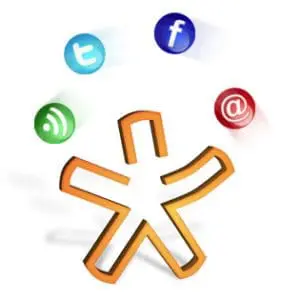 Social selling for B2B sales and marketing expands on the age-old basics of getting to know your customer and meeting their needs—while making full use of today’s amazing social media tools. In the old days, you got to know your customer by going into an office and looking at what was on their walls and starting a conversation.
Social selling for B2B sales and marketing expands on the age-old basics of getting to know your customer and meeting their needs—while making full use of today’s amazing social media tools. In the old days, you got to know your customer by going into an office and looking at what was on their walls and starting a conversation.
Today, you can share on social media to humanize your brand, and give your company a personality amidst the conversations, communities, and blogs that millions of prospects frequent. Customers want meaningful connections in their preferred communication channels. The blunt, un-nuanced “Mad Men” style of selling is no longer effective. Social selling techniques allow business professionals to engage with customers and prospects with relevance and purpose. It’s not so much about the what as the how and why.
With social selling, you’re no longer simply pushing information about products and services out to your audience. Instead, you’re discovering what they’re passionate about, which can lead naturally—organically—into a discussion of how you can solve a problem or improve their lives, and why your company is the right choice to help them.
Social selling is a two-way street, a relationship, a conversation. I like to describe the basic tenets of this process by using five “E” words:
1. Educate.
Here’s where the “why” comes in. What exactly do you have that they need? Why should they buy something from you? Don’t sell; describe and explain. Let them see value and benefits and results, not lengthy product descriptions and spec sheets. (There’s a place for these on your site, however, as a valuable self-serve option for visitors!)
Perhaps more important than educating your audience on the value and benefits of your products and services is educating them in the broader sense—to help them succeed. To that end:
- Assemble your best ideas and share them with your audience.
- Create information they can act on to build their own businesses, and give it to them in a variety of ways: ebooks, tip sheets, articles, and commentary.
- Participate in forums and discussions that pertain to your business, and make sure your salespeople know all the best gathering places.
Establishing your brand as a helpful expert is a longer-term investment, but an important one. When you are always willing to offer advice or suggest resources—without expectation of making a sale—you will be remembered at important “trigger times” that precede a buying decision.
2. Enchant.
Enchantment is the human voice that enlivens a systematic process. Enchantment includes sharing yourself (as a representative of your brand) in an authentic, relevant and transparent way—at the time of need—to build rapport.
Creating an online presence is a big part of brand identity, so build one that will attract the audience you want. You have something that many people need, so draw them in by building an appealing and genuine persona. Is your voice “business friendly?” Humorous? Do you encourage spirited debate, or do you want to avoid controversy and stick to a more academic tone?
Creating a “corporate style” is similar to creating a logo and color scheme. Just as you create a stylesheet—guidelines for how you present your brand to the public—it’s a good idea to create a set of guidelines for your employees to set expectations for how they should conduct themselves in social interactions.
Be sure to make this a specific task when new employees come aboard, so they know exactly what is expected of them.
3. Engage.
Like. Comment. Chat. Get involved. You’ve shared your passions; encourage others to do the same. Even if they’re not potential customers, they have friends that are.
You can build good engagement habits over time. Start by listening and gathering information, consistently. A great habit to develop is to take some time each day to view your social universe and participate, reach out, and keep relationships active.
We’re all busy, and it’s easy to lose track of people, but great tools like Nimble.com make it hard to drop a ball. Monitor and act on opportunities to interact socially. A few minutes a day is all it takes to make sure nothing slips through the cracks.
4. Embrace.
Identify those individuals and companies whose needs mesh with your strengths. Formalize connections and continue to talk, listen and watch (and even keep an eye on your competition and gather a bit of intelligence!).
LinkedIn groups are one great way to share experiences, ask questions, get to know people, and develop ideas. There are thousands of groups, with something for every interest.
With group discussions, you can have seminar-level conversations that attract thought leaders and give participants valuable, actionable insights. You can see which of your top-level contacts are in a group—another opportunity to deepen the relationship!
Quora is another way to participate in thoughtful give-and-take on business issues. Quora uses a question-and-answer format organized and crowdsourced by a community of users. Ask a question on Quora and you could get straightforward advice from experts, tips, links, or the input of a budding comedian, as this question illustrates.
5. Empower.
Empowerment means giving people the tools they need to be successful. When you have access to the best ways to engage and educate your prospects, clients, and peers, you can become a trusted advisor and increase selling opportunities.
At Nimble, we believe that when you see each person in your contact list in a multi-faceted way, not just as a flat business card record, you have a much richer view. This view is invaluable in helping you make strategic decisions about everything—from the content that you present, to the employees you hire, to the charities you support, to knowing the right time to reach out to a prospect.
The Social Selling Advantage
By factoring these “Five E’s” into your daily tasks and brand culture, you can take every opportunity to show your readers, prospects, and fans how their lives can be better and their businesses run more efficiently—and how your presence in their lives helps them fulfill their own personal and professional missions.
That’s social selling.
 Jon Ferrara is the CEO and founder of social CRM vendor Nimble. Previously, he co-founded GoldMine Software Corp., one of the early pioneers in the Sales Force Automation and Customer Relationship Management software markets. This article was published originally at SoftwareAdvice.com, and is reposted here with the author’s permission — thanks, Jon!
Jon Ferrara is the CEO and founder of social CRM vendor Nimble. Previously, he co-founded GoldMine Software Corp., one of the early pioneers in the Sales Force Automation and Customer Relationship Management software markets. This article was published originally at SoftwareAdvice.com, and is reposted here with the author’s permission — thanks, Jon!





